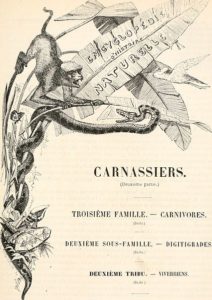Description and the Nonhuman View of Nature
by Joanna Stalnaker
Today, when thinking about the divide between literature and science, we may tend to associate literature with the imagination and science with observation and description. The prehistory of this assumption can be traced back to the eighteenth century, when description first emerged as a contested category in urgent need of definition, beyond the traditional rhetorical notion of enargeia, the figure by which an absent object or person is made vividly present through words. As Lorraine Daston, John Bender, Michael Marrinan, Cynthia Sundberg Wall, and I have shown, the practice of description underwent significant transformations in the eighteenth century, as competing regimes of description emerged and were defined in opposition to each other. Denis Diderot and Jean le Rond d’Alembert’s famous Encyclopédie, published over two decades beginning at midcentury, offered three separate entries on description: one for geometry, one for natural history, and one for belles lettres. A later iteration of that work, the Encyclopédie méthodique, added yet another entry on the newly invented genre of descriptive poetry, which purportedly undermined classical poetics by failing to subsume description to narrative or didactic design. Yet the disciplinary landscape operative in these definitions—and in the descriptive practices surrounding them—cannot be easily mapped onto our familiar opposition between imaginative literature on the one hand and scientific description on the other.
 In what follows, I will look at two writers from the French eighteenth century whose work illustrates the contingency of modern categories and definitions of description. The first is the famous naturalist and renowned stylist Georges-Louis Leclerc de Buffon, whose multivolume Histoire naturelle spurred the vogue for natural history across Europe in the second half of the eighteenth century. The second is the once-celebrated but now obscure poet Jacques Delille, who took the Scottish poet James Thomson as his model and introduced the so-called genre of descriptive poetry in France in the last decades of the Old Regime. Taken together, these two writers exemplify what the great naturalist and zoologist Georges Cuvier called “the age of description.” This age has fallen out of view since Cuvier’s lifetime, lost to the modern fracture between literature and science. Yet I will argue that it holds special relevance for us today, at a time when short-story writers and political theorists alike share an impulse to ascribe agency to nonhuman things and to question the centrality of human perspectives. One of the biggest surprises to emerge from the unfamiliar landscape of the eighteenth-century age of description is its elaboration of a poetics of description grounded in dramatic shifts in scale and nonhuman perspectives on nature. Continue reading …
In what follows, I will look at two writers from the French eighteenth century whose work illustrates the contingency of modern categories and definitions of description. The first is the famous naturalist and renowned stylist Georges-Louis Leclerc de Buffon, whose multivolume Histoire naturelle spurred the vogue for natural history across Europe in the second half of the eighteenth century. The second is the once-celebrated but now obscure poet Jacques Delille, who took the Scottish poet James Thomson as his model and introduced the so-called genre of descriptive poetry in France in the last decades of the Old Regime. Taken together, these two writers exemplify what the great naturalist and zoologist Georges Cuvier called “the age of description.” This age has fallen out of view since Cuvier’s lifetime, lost to the modern fracture between literature and science. Yet I will argue that it holds special relevance for us today, at a time when short-story writers and political theorists alike share an impulse to ascribe agency to nonhuman things and to question the centrality of human perspectives. One of the biggest surprises to emerge from the unfamiliar landscape of the eighteenth-century age of description is its elaboration of a poetics of description grounded in dramatic shifts in scale and nonhuman perspectives on nature. Continue reading …
This article looks at two writers of the French eighteenth century, the naturalist Georges-Louis Leclerc de Buffon and the poet Jacques Delille, whose innovative practices of description call into question our modern opposition between literature and science and raise the issue of how literature might be transformed through attention to nonhuman views of nature.
JOANNA STALNAKER teaches in the French Department at Columbia University. She is the author of The Unfinished Enlightenment: Description in the Age of the Encyclopedia (Cornell, 2010) and is currently working on a book about the last works of the French philosophes at the end of the Enlightenment.
